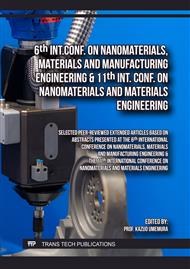p.45
p.51
p.59
p.67
p.75
p.81
p.87
p.95
p.101
Investigating the Effect of HCL Pre-Treatment and Single Step Impregnation-Activation Carbon of K2FeO4- KOH Catalyst on the Graphitization Process of Empty Palm Oil Fruit Bunches
Abstract:
The conversion of biomass to graphite requires a catalyst to promote the graphitization process. Effective pre-treatment and activation of the carbon precursor are crucial for improving the efficiency and success of biomass graphitization using metal catalysts. In this work, we investigate the combined effects of HCl pre-treatment and single-step impregnation carbon with K2FeO4, along with KOH activation, on the graphitization process of Empty Palm Oil Fruit Bunches (EPOFB). X-ray fluorescence (XRF) data reveal that HCl pre-treatment effectively eliminates significant impurities, such as alkali metals, alkaline earth metals, and transition metals, which can hinder the graphitization process. XRD and Raman spectroscopy results indicate that the combination of HCl pre-treatment and single-step impregnation carbon with K2FeO4, along with KOH activation significantly improves the graphitic quality of the carbon. High-quality graphitic carbon with an IG/ID ratio of 12.35 for the sample CpreHCl_K2FeO4(0.07)_KOH_1200 (EPOFB carbon pre-treated with HCl, followed by impregnation with K2FeO4 and activation with KOH, and then pyrolyzed at 1200°C). This particular sample displays a porous surface morphology and has a surface area of 876.407 m²/g. This study underscores the importance of acid pre-treatment and chemical activation in optimizing the preparation of high-quality graphitic carbon from biomass.
Info:
Periodical:
Pages:
75-80
Citation:
Online since:
March 2025
Keywords:
Price:
Сopyright:
© 2025 Trans Tech Publications Ltd. All Rights Reserved
Share:
Citation:



